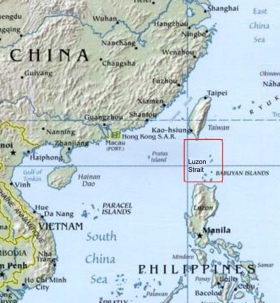Giant wave of understanding in South China Sea

Their effect on the surface of the ocean is negligible, producing a rise of just inches that is virtually imperceptible on a turbulent sea. But internal waves, which are hidden entirely within the ocean, can tower hundreds of feet, with profound effects on the Earth's climate and on ocean ecosystems.
Now new research, both in the ocean and in the largest-ever laboratory experiments to investigate internal waves, has solved a longstanding mystery about exactly how the largest known internal waves, in the South China Sea, are produced. The new findings come from a team effort involving MIT and several other institutions, and coordinated by the Office of Naval Research (ONR).
Seen in cross-section, these waves resemble surface waves in shape. The only difference between an underwater wave and the water around it is its density, due to temperature or salinity differences that cause ocean water to become stratified.
Though invisible to the eye, the boundary between colder, saltier water below and warmer, less-salty water above can be detected instrumentally. That boundary layer can resemble the ocean's surface, producing waves that reach towering heights, travel vast distances, and can play a key role in the mixing of ocean waters, helping drive warm surface waters downward and drawing heat from the atmosphere.
Because these internal waves are hard to detect, it is often a challenge to study them directly in the ocean. But now Thomas Peacock, from MIT, teaming with researchers from the Ecole Centrale de Lyon, the Ecole Normale Superieure de Lyon, and the University of Grenoble Alpes, all in France, and the Woods Hole Oceanographic Institution, have completed the largest wave laboratory experiment of its kind.
The team performed laboratory experiments studying the production of internal waves in the Luzon Strait, between Taiwan and the Philippines. "These are the most powerful internal waves discovered thus far in the ocean," Peacock says. "These are skyscraper-scale waves."
These solitary waves have been observed to reach heights of 170 meters (more than 550 feet) and can travel at a leisurely pace of a few centimeters per second. "They are the lumbering giants of the ocean," Peacock says.
The team's large-scale laboratory experiments on the generation of such waves used a detailed topographic model of the Luzon Strait's seafloor, mounted in a 50-foot-diameter rotating tank in Grenoble, France, the largest such facility in the world. The experiments showed that these waves are generated by the entire ridge system on that area of seafloor, and not a localized hotspot within the ridge.
Read more at the Massachusetts Institute of Technology.
Luzon Strait map via google images.
2014©. Copyright Environmental News Network